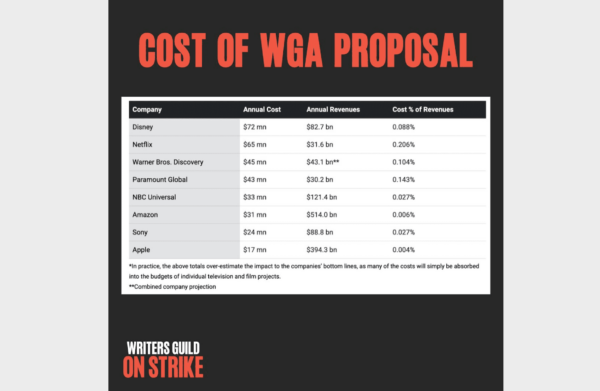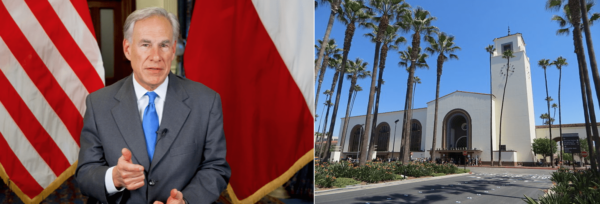Striking members of the Writers Guild of America will head to the picket lines as usual Friday, one day after the union’s negotiators told rank and file the latest contract offer from Hollywood studios was “neither nothing, nor nearly enough.”
In a message to WGA members Thursday, the union’s negotiating committee made its first detailed response to this week’s public release of the Alliance of Motion Picture and Television Producers’ current contract offer. The release by the AMPTP, which came after a fruitless negotiating session Tuesday night, was deemed by the WGA as an attempt to sow divisions among union members.
WGA negotiators told union members the latest AMPTP offer is riddled with “half measures,” and that the union will continue to push for more universal improvements in contract terms.
The union also called for continued strength and solidarity among members, asking them to continue showing their resolve by remaining on picket lines.
Union officials said the latest AMPTP offer includes some salary boosts, “but only for a statistically tiny category of screenwriters, excluding all but the first writers of original screenplays.”
The offer also includes a guarantee of minimum writing staff size for television, “but the loopholes, limitations and omissions in their modest proposal … make them effectively toothless,” according to the union.
WGA negotiators said there has been movement by the studios on protections against the use of artificial intelligence, “but we are not yet where we need to be. As one example, they continue to refuse to regulate the use of our work to train AI to write new content for a motion picture.”
The studios also made a concession by “offering to allow six WGA staff to study limited streaming viewership data for the next three years,” but a viewership-based compensation package would have to wait until the next contract negotiations in three years, according to the union. “In the meantime, no writer can be told by the WGA about how well their project is doing, much less receive a residual based on that data,” according to the WGA negotiators.
“The companies’ counteroffer is neither nothing, nor nearly enough,” according to the WGA negotiators. “We will continue to advocate for proposals that fully address our issues rather than accept half measures like those mentioned above and other proposals not listed here.”
The negotiating team again circulated a chart with cost summaries for each studio of the union’s proposals, with all of them amounting to fractions of a percent of the studios’ annual revenues.
“Despite the AMPTP’s attempt at a detour around us, we remain committed to direct negotiations with the companies,” according to the message sent to WGA members. “That’s actually how a deal gets made and the strike ends. That will be good for the rest of the industry and the companies as well.”
WGA negotiators met Tuesday with representatives of the AMPTP, along with executives including Disney CEO Bob Iger, Warner Bros./Discovery CEO David Zaslav, Universal Chairwoman Donna Langley and Netflix CEO Ted Sarandos.
Union officials said afterward that they attended the meeting “in hopes that the companies were serious about getting the industry back to work,” but they were instead “met with a lecture about how good their single and only counteroffer was.”
AMPTP officials then released a statement to media outlets professing to be focused on resolving the strike and touting the benefits of the alliance’s counter-offer to union proposals.
“The offer recognizes the foundational role writers play in the industry and underscores the companies’ commitment to ending the strike,” according to the statement from AMPTP, which bargains on behalf of the major studios and streamers.
According to the AMPTP, the studios’ offer includes the largest pay bump for the WGA in 35 years, with an increase of 5% in the first year, along with bumps of 4% and 3.5% in the following two years.
The WGA had sought a 6% increase to minimums and residual bases in the first year, followed by 5% increases in the second and third years, according to the Los Angeles Times.
The studio offer also includes increased authority for showrunners to determine staffing in the writing room, along with extensive protections for writers against the use of artificial intelligence and increases in residuals for streaming programs, according to the AMPTP. The studios have also agreed to provide details on streaming viewership numbers, with the union pushing to tie compensation to those figures.
“Our priority is to end the strike so that valued members of the creative community can return to what they do best and to end the hardships that so many people and businesses that service the industry are experiencing,” AMPTP President Carol Lombardini said in a statement.
The WGA went on strike May 2. It was joined on the picket lines by SAG-AFTRA actors last month, effectively shutting down all production.
The studios have generally said they want the WGA and SAG-AFTRA to agree to similar terms already approved by the Directors Guild of America, which includes a roughly 12.5% salary increase and an estimated 21% jump in streaming residuals, along with assurances that artificial intelligence will not supplant the duties of human beings.







